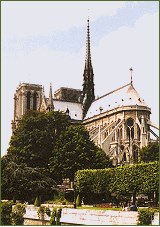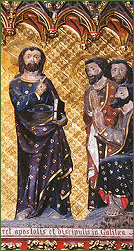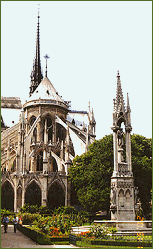|
Now you have no doubt heard of the novel by Victor Hugo called the Hunchback of Notre
Dame and this particular story was what fuelled people to get together and raise money for
its restoration and even though many treasures were destroyed during the French
Revolution, the cathedral is now virtually back to its former glory.
In fact, following the start of World War II, it was feared that German bombers could
destroy the stained glass windows and as a result, on 11th September 1939, they were
removed and restored at the end of the war.
One particular stained glass window, which is round, was the biggest window in the world
when it was produced back in the thirteenth century, and called the Rose Window, today it
still contains its original medieval glass with scenes from the bible.
Notre Dame translates as Our Lady from French and today this monument in Paris is still used as a Roman Catholic
cathedral for Sunday mass, is the seat of the Archbishop of Paris and is utilised for
major events when the famous bell is rung. But these days, the bell is rung
automatically rather than with manpower and by taking a climb up the spiral staircase, you
can get to see this enormous bell that was saved from being melted down.
The Notre Dame de Paris was among the first buildings in the world to use the flying
buttress style and by climbing the steps you can see this construction along with the
gargoyles on the outside of the building, which were put in place to ward away evil
spirits.
Every cathedral has an organ and the Notre Dame is no exception, but in fact it has
actually had several, although the first ones were far too inadequate for the size of the
building. The first sensible organ was installed in the early 1700's and even today
some of the original pipe work remains, but one of the cathedral organs can be viewed at
the Musee de Notre Dame de Paris, along
with the music scores, notes and some personal articles that are on display from Louis
Vierne. Vierne was the most well known of all the organists and was the main key
organist from 1900, holding the position for thirty-seven years, and he actually died at
the Notre Dame cathedral organ, which was
his life-long wish.
The museum itself is only one street and a very short walk away from the cathedral and
although small is incredibly fascinating and holds some extremely old and interesting
documents such as drawings, plans and engravings, which reveal the mysteries and various
development stages of the Notre Dame de Paris Cathedral.
The Musee de Notre Dame de Paris also recounts life in the City from Lutecia before it was
known as Paris, but getting back to Notre Dame
Cathedral itself, there are so many fascinating this to see on a visit here.
Even though going up to the bell tower is great, you can also climb even higher, with
approximately another 140 steps, where you have a fantastic view of Paris, especially at
night when the city is all lit up.
Also, in the square to the front of Notre Dame is a plaque that was put in place by Andr?
Michelin, who was the founder of the Michelin tyre business and it is from this point that
all distances in France are measured.
The Notre Dame de Paris is open every day of the year and is free to enter although there
is a charge to venture up the tower, which is accessed on the outside of the church on the
left hand side when you are looking at the main entrance of the cathedral.
You can also have a guided visit, which is organised by the cathedral staff itself and
these are conducted in different languages on different days of the week. For
instance English guided tours are provided on Wednesday at 2pm, Thursday at 2pm and a
Saturday at 2.30pm, whereas Japanese guided tours are held on a Friday at 2pm except for
the first Friday of the month and every Friday during Lent.
Other language tours such as Spanish, Russian, etc are held at different times, but any of
these can be cancelled if there is a special occasion, such as when the Requiem Mass of
Jean-Marie Cardinal Lustiger, archbishop emeritus of Paris, was held in the August of
2007, so it always worth checking with staff on site, or phoning prior.
So whether you are going for pilgrimage or just as a tourist, this is a fascinating
building, which has become one of the famous landmarks
in Paris and is not to be missed on your holiday in
France.
|
|




